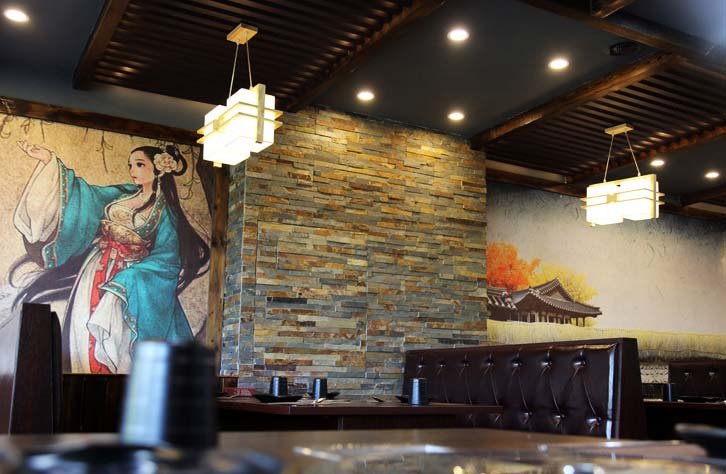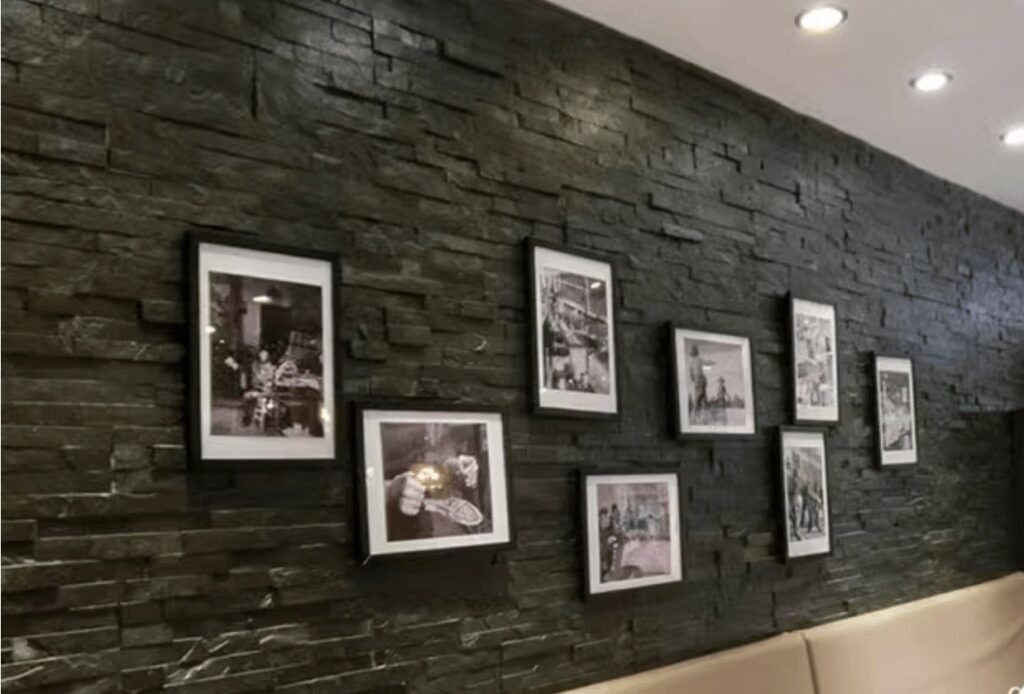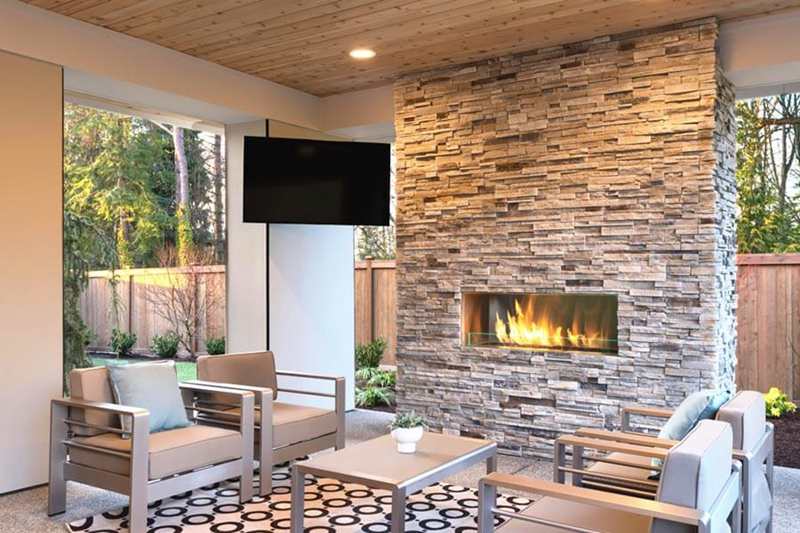Worried about dirt and grime ruining the look of your stacked veneer stone? Many homeowners struggle to keep their stone features looking pristine, especially with the natural wear and tear they endure. Harsh chemicals can damage the stone, while neglecting maintenance leads to unsightly buildup and potential long-term damage.
That’s why mastering gentle cleaning techniques and proactive maintenance is essential. In this guide, we’ll walk you through the best practices for cleaning and maintaining your stacked veneer stone, ensuring it retains its beauty and durability for years to come. Drawing on our 15 years of experience at Top Source Slate, we’ll share expert tips to keep your stone surfaces looking “brand-spankin’ new”。
Crucial Preparations Before Stacked Stone Veneer Cleaning
Before you start scrubbing, it’s essential to get everything in order. Proper preparation will not only make the cleaning process more effective but also protect your stacked veneer stone and its surroundings. This guide, brought to you by Coco from Top Source Slate with over 15 years of experience, ensures you tackle this task like a pro, maintaining the beauty and integrity of your stone veneer.
Using the right preparation techniques before cleaning 積み重ねられた石のベニヤ ensures both effective cleaning and the long-term preservation of the stone’s appearance and structural integrity.
Assessing the Stone Veneer: Identifying Stone Type and Condition
First, take a close look at your stone veneer. Determine the type of stone (slate, quartzite, etc.) and its condition. Is it heavily soiled, stained, or simply dusty? Understanding the material and the extent of cleaning needed will guide your choice of cleaning solutions. At Top Source Slate, we always advise our clients to know their stone before beginning any maintenance.
Knowing the condition of your stacked veneer stone is vital. Check for any cracks, loose pieces, or existing damage. Addressing these issues before cleaning prevents further harm. For instance, loose stones should be re-adhered, and cracks should be sealed. Different types of stone may react differently to cleaning agents, so confirm your stone type and test any cleaner in a small, inconspicuous area first.
Gathering Necessary Cleaning Supplies: Tools and Solutions
Having the right tools and cleaning solutions on hand is crucial. You’ll need items such as a soft-bristled brush, a garden hose with adjustable spray nozzle, buckets, and appropriate cleaning solutions. Always use manufacturer-approved or recommended cleaners to avoid damaging the stone. Top Source Slate recommends gentle, pH-neutral cleaners to protect the 天然石。
Avoid harsh chemicals like bleach or acid-based cleaners. These can discolor or erode the stone surface. For stubborn stains, consider specialty stone cleaners designed for your specific type of stone. When selecting your cleaning tools, ensure they are non-abrasive. Abrasive brushes or scrub pads can scratch the surface of the “ライドオアディー” stacked veneer stone, diminishing its appearance.
Protecting Surrounding Areas: Preventing Damage
Protecting the areas around your stacked veneer stone is a step often overlooked. Cover nearby plants, windows, and furniture with plastic sheeting or drop cloths. This prevents cleaning solutions from causing damage or discoloration to these surfaces. Securing these areas beforehand saves time and effort in post-cleaning cleanup.
Pay special attention to protecting metal surfaces, as some cleaning solutions can cause corrosion. Use painter’s tape to secure plastic sheeting and prevent runoff. Redirect downspouts or drainage areas to avoid flooding or water damage during the cleaning process. Proper protection ensures a safe and efficient cleaning operation.
Safety Precautions: Protecting Yourself and the Stone
Your safety is paramount. Wear safety glasses and gloves to protect yourself from splashes and potential skin irritation from cleaning solutions. Ensure adequate ventilation when working indoors or in enclosed spaces. If using a pressure washer, maintain a safe distance and use a wide nozzle setting to prevent damaging the stone.
それが来たら “stone veneer cleaning”, always read and follow the manufacturer’s instructions for any cleaning products you use. Test the cleaning solution on a small, hidden area of the stone to ensure it doesn’t cause discoloration or damage. Never mix different cleaning solutions, as this can create dangerous fumes. Keep children and pets away from the cleaning area to prevent accidental exposure to chemicals.
Remember, regular maintenance is key to preserving the beauty of your stacked veneer stone. With proper preparation and the right techniques, you can keep your stone looking its best for years to come. For the best long-term care, consider applying a stone sealant after cleaning, as recommended by Top Source Slate. This will help protect against future stains and water damage. Following these steps ensures a safe, effective, and long-lasting cleaning process.

The Ultimate Step-by-Step Guide to Cleaning Stacked Stone Veneer
Keeping your stacked veneer stone looking its best requires the right approach. This guide provides a detailed, step-by-step method for cleaning your 積み上げられた石, whether you’re a homeowner or a cleaning professional. Brought to you by Coco from Top Source Slate, with over 15 years of experience, this guide will help you maintain stone veneers effectively, ensuring longevity and aesthetic appeal.
“Cleaning stacked stone veneer involves gentle techniques and appropriate cleaning solutions to preserve the stone’s natural beauty and prevent damage.
Gentle Cleaning Methods: Dusting and Vacuuming Techniques
Start with the gentlest methods. Use a soft brush or a vacuum with a brush attachment to remove loose dust and debris from the surface of the “stacked veneer stone”. This prevents dirt from becoming embedded during deeper cleaning. Regular dusting keeps your stone looking fresh and reduces the need for harsher cleaning methods later on.
When vacuuming, be sure to use the brush attachment to avoid scratching the stone surface. For hard-to-reach areas, use a small brush to loosen the dirt, then vacuum it up. This initial step is crucial for maintaining stone veneers and preventing build-up over time. Regular dusting and vacuuming can significantly extend the life and beauty of your stone.
Deep Cleaning Solutions: Mild Detergents and Application
For a deeper clean, use a mild, pH-neutral detergent mixed with water. Apply the solution to the stone surface using a soft sponge or cloth. Avoid using harsh chemicals or abrasive cleaners, as these can damage the stone. Top Source Slate recommends using only manufacturer-approved cleaning solutions to maintain your warranty and the stone’s integrity.
When applying the cleaning solution, work in small sections to prevent the solution from drying on the surface. Gently scrub the stone, paying attention to areas with visible dirt or stains. Avoid using excessive pressure, as this can damage the stone. A soft-bristled brush can be used for textured surfaces to reach into crevices and remove dirt effectively. Remember, patience and a gentle approach are key to effective “stone cladding maintenance”。
Stain Removal Techniques: Addressing Common Stains
Different stains require different approaches. For oil-based stains, use a poultice made of baking soda and water. Apply the poultice to the stain, let it dry, and then gently scrape it off. For rust stains, use a specialized rust remover designed for stone. Always test any stain removal technique in an inconspicuous area first to ensure it doesn’t damage the stone.
For organic stains like algae or mildew, use a solution of water and a mild bleach. Apply the solution to the affected area, let it sit for a few minutes, and then rinse thoroughly. Always wear gloves and eye protection when working with bleach. If you are unsure about the type of stain or the appropriate cleaning method, consult a professional stone cleaner. Regular cleaning helps prevent stains from setting in, making them easier to remove. The best way to clean stacked stone walls often involves identifying the stain and using a targeted cleaning solution.
Rinsing and Drying: Ensuring Thorough Removal of Residue
After cleaning and stain removal, it’s crucial to rinse the stone thoroughly with clean water. Use a garden hose with a gentle spray nozzle to remove all traces of cleaning solution. Pay attention to crevices and textured areas where residue might accumulate. Residual cleaning solution can attract dirt and cause discoloration over time.
Once rinsed, allow the stone to air dry completely. You can use a soft, clean cloth to speed up the drying process. Ensure the stone is completely dry before applying any sealant or protective coating. Regular cleaning and proper drying will keep your stacked veneer stone looking beautiful for years to come. Remember to avoid power washers unless you have experience with them, as they can damage the stone if used improperly. Following these steps will ensure effective cleaning and help “maintain stone veneers” for years to come.
Cleaning Solution Comparison for Stacked Stone
| 洗浄液 | Effectiveness | Risk of Damage | 料金 | Recommended Use | Top Source Slate Rating (1-5) |
|---|---|---|---|---|---|
| pH-Neutral Detergent | 適度 | 低い | 低い | 一般的な清掃 | 4 |
| Baking Soda Poultice | 適度 | 非常に低い | 非常に低い | Oil-Based Stains | 4 |
| Specialized Stone Cleaner | 高い | 低い | 適度 | Stubborn Stains | 5 |
| Mild Bleach Solution | 高い | 適度 | 低い | Organic Stains | 3 |
| Vinegar Solution | 低い | 適度 | 非常に低い | Light Cleaning | 2 |
The Ultimate Guide to Protecting and Maintaining Your Stacked Stone Veneer
Protecting your stacked veneer stone is crucial for maintaining its beauty and structural integrity for years to come. This guide, brought to you by Coco from Top Source Slate with over 15 years of experience, focuses on long-term maintenance practices, including sealing, to ensure your ストーンベニア remains in top condition. Following these tips will help you maintain stone veneers and keep them looking their best.
Proper sealing and maintenance are essential for preserving the beauty and extending the lifespan of stacked stone veneer.”
The Importance of Sealing: Benefits and Types of Sealants
Sealing your stacked veneer stone offers numerous benefits. It protects against water damage, stains, and environmental pollutants. Sealants create a barrier that prevents moisture from penetrating the stone, reducing the risk of cracking and discoloration. There are two main types of sealants: penetrating and film-forming. Penetrating sealants soak into the stone, providing protection from within, while film-forming sealants create a protective layer on the surface. Top Source Slate recommends using penetrating sealants for a more natural look and longer-lasting protection.
Choosing the right sealant depends on the type of stone and its intended use. For exterior applications, use a sealant that is resistant to UV rays and freeze-thaw cycles. For interior applications, focus on stain resistance and ease of cleaning. Always read the manufacturer’s instructions and choose a sealant specifically designed for natural stone. Regular sealing is essential for how to maintain natural stone veneer and keeping it protected from the elements.
Application Techniques: How to Apply Sealant Properly
Proper application is key to achieving the full benefits of a sealant. Before applying, ensure the stone is clean and dry. Use a brush, roller, or sprayer to apply the sealant evenly. Avoid applying too much sealant, as this can create a glossy or unnatural look. Apply a thin, even coat and allow it to dry according to the manufacturer’s instructions.
For best results, apply two coats of sealant, allowing the first coat to dry completely before applying the second. Pay attention to joints and crevices, ensuring they are fully sealed. Wipe off any excess sealant with a clean cloth. Regular inspection and reapplication of sealant every few years will help maintain stone veneers and protect against damage. Correct application techniques ensure your stacked veneer stone remains protected and beautiful.
Regular Maintenance Tips: Preventing Future Buildup
Regular maintenance is essential for preventing future buildup and keeping your stacked veneer stone looking its best. Dust or vacuum the stone regularly to remove loose dirt and debris. Clean spills immediately to prevent staining. Use a mild, pH-neutral cleaner for routine cleaning. Avoid harsh chemicals or abrasive cleaners, as these can damage the stone.
Inspect the stone regularly for cracks, loose pieces, or signs of water damage. Address any issues promptly to prevent further damage. Keep plants and other objects away from the stone to prevent staining or discoloration. By following these simple maintenance tips, you can prolong the life and beauty of your stacked veneer stone. Proper maintenance also contributes significantly to effective stone veneer cleaning. These cleaning tips for stone veneer siding are invaluable.
Troubleshooting Common Issues: Addressing Potential Problems
Despite your best efforts, problems can still arise. Efflorescence, a white, powdery deposit, can occur on stone surfaces due to moisture. To remove efflorescence, use a specialized efflorescence cleaner. Cracking or crumbling can be caused by water damage or freeze-thaw cycles. Repair any cracks promptly and ensure proper drainage to prevent future damage.
Staining can be a common issue, especially in high-traffic areas. Use appropriate stain removal techniques for the specific type of stain. If you encounter a problem you can’t resolve, consult a professional stone restoration expert. Addressing potential problems promptly can prevent them from escalating and preserve the beauty of your stacked veneer stone. Regular maintenance and prompt repairs will keep your stone looking its best for years to come. Remember that professional advice can be invaluable in tackling complex issues.
Sealant Comparison Chart for Stacked Stone Veneer
| シーラントの種類 | Material Compatibility | 耐久性 | Water Resistance | UV Resistance | Price Range | 最も重要なソース スレートの推奨事項 |
|---|---|---|---|---|---|---|
| Penetrating Silicone | Most Stone Types | 3~5年 | 高い | 適度 | $$ | Excellent for interior |
| Acrylic Sealant | Porous Stone | 2~3年 | 適度 | 低い | $ | Budget-friendly indoor |
| Siloxane Based | All Stone Types | 5-7 Years | 高い | 高い | $$$ | Best for exterior use |
| Fluoropolymer | Sensitive Stones | 7-10 Years | 非常に高い | 非常に高い | $$$$ | Premium long-term |
| Water-Based | General Use | 2~4年 | 適度 | 適度 | $$ | Easy application |

結論
私が在籍していた頃から トップソーススレート, I’ve learned that the secret to keeping stacked veneer stone looking great isn’t just about cleaning—it’s about protecting your investment. Knowing the right techniques can save you time, money, and a whole lot of headaches.
適切なアプローチがあれば、誰でも石の表面を手付かずに見せ続けることができます。私の経験は、穏やかなクリーニングと積極的なシーリングを組み合わせることが “ロックソリッド” 今後数年間、その美しく自然な外観を維持するための戦略。
So, take these tips to heart. A little effort goes a long way in preserving the beauty and integrity of your stone. And remember, if you ever feel overwhelmed, reaching out to a professional is always a smart move.
よくある質問
Q1: What is the best method to clean stacked veneer stone?
A1: The best method to clean stacked veneer stone is to use a pH-neutral stone cleaner applied with a soft bristle brush or cloth. Avoid using acidic or bleach-based cleaners as they can harm the stone’s surface.
Q2: How often should you seal stone veneer surfaces?
A2: Stone veneer surfaces should typically be sealed every 1-3 years. The frequency depends on the environmental exposure and wear level. Applying a quality stone sealer can enhance protection against stains and moisture.
Q3: Can you use a pressure washer on stone veneer?
A3: Using a pressure washer on stone veneer is not recommended, as the high pressure can damage the veneer’s surface and loosen the stone pieces. It’s best to clean using a low-pressure hose and avoid harsh tools.
Q4: What kind of sealer should be used on natural stone veneer?
A4: A penetrating or impregnating sealer is best for 天然石ベニヤ. It seeps into the pores and provides protection without affecting the stone’s natural look or causing a surface film.
Q5: How does sealing affect the appearance of stone veneer?
A5: Sealing stone veneer can enhance its natural color and texture, giving it a wet look that intensifies the existing hues. However, using a non-enhancing sealer will keep the stone’s natural look unchanged.
Q6: Are there eco-friendly cleaning options for stone veneer?
A6: Yes, eco-friendly options include using a mix of warm water and baking soda or a specialized eco-friendly stone cleaner. These methods help preserve the environment while keeping your stones clean.
Q7: What are common maintenance tips for stone cladding?
A7: Regularly dusting or washing with mild soap and water, re-sealing as needed, and inspecting for damages to repair promptly are essential maintenance tips for stone cladding。
Q8: Do stone veneers improve the longevity and appearance of walls?
A8: Yes, stone veneers are resilient and withstand weather conditions, providing long-term durability and enhancing the aesthetic appeal of walls with their natural and varied textures.
外部リンク
- How to Clean and Maintain Stone Veneers
- Sealing and Protecting Natural Stone Veneers
- The Impact of Maintenance on Stone Veneer Longevity
- Efficient Cleaning Techniques for Stone Surfaces
- Best Practices for Sealing Stone Cladding
- Eco-friendly Methods for Stone Facade Maintenance
- Understanding the Care and Preservation of Stone Veneer
- The Role of Sealing in Stone Decor Preservation


